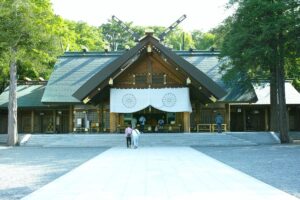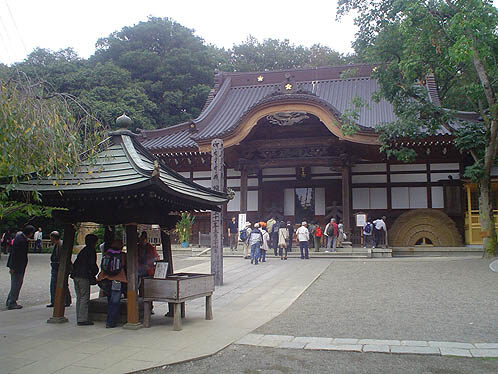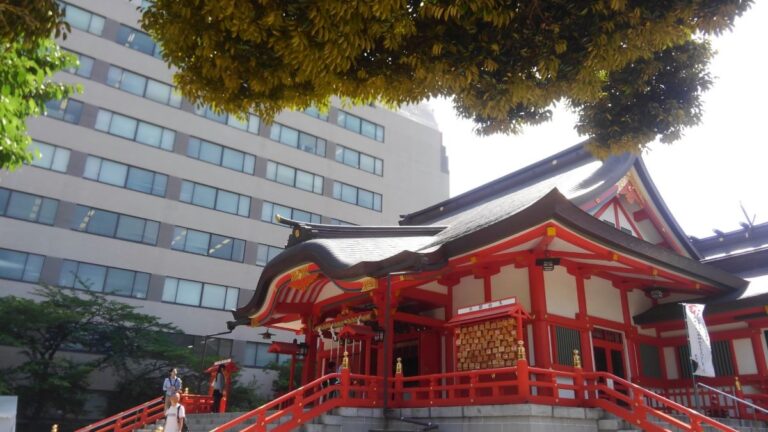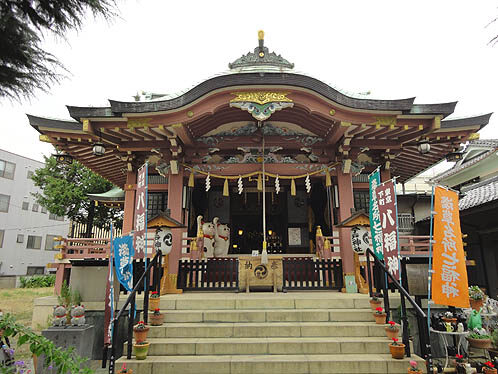Meiji Jingu (Shibuya Ward, Tokyo)

Nishiarai Daishi (Adachi-ku, Tokyo)
Kameido Tenjinja Shrine (Koto-ku, Tokyo)
This shrine is located in Kameido, Koto-ku, north of JR Kameido Station, and is well known as the “Tenjin-sama” of the downtown area. Since the shrine enshrines Sugawara Michizane, the god of learning, many students visit here to pray for success in entrance examinations. It is also famous for its beautiful flowers. The deities enshrined at the shrine are Ama-no-Okami (Lord Michizane Sugawara) and Amabohi-no-Mikoto (the ancestral god of the Sugawara family).
Tomioka Hachiman Shrine (Koto-ku, Tokyo)
Located just east of Fukagawa Fudoson in Tomioka, Koto-ku, it is the largest Hachiman Shrine in Tokyo and is popularly known as “Fukagawa no Hachiman-sama”. It is well known for the Fukagawa Hachiman Festival, one of the three major festivals of Edo, which is held on August 15 every year. The shrine is dedicated to Emperor Ojin [Homutawake-no-mikoto].
Naritasan Fukagawa Fudo Hall (Koto-ku, Tokyo)
It is a temple of the Chizan school of the Shingon sect, a branch temple of Naritasan Shinshoji Temple, located in Tomioka, Koto-ku, near Monzennaka-cho Station on the subway line. The temple is a branch temple of Naritasan Shinshoji Temple of the Chizan sect of Shingon Buddhism. The deity’s divine virtues include the fulfillment of various wishes, protection from bad luck, academic success, traffic safety, good luck, and increased money.
Gokokuji Temple (Bunkyo-ku, Tokyo)
Located in Otsuka, Bunkyo-ku, northwest of Ochanomizu University, this temple is a Shingon sect temple known for its annual Hana-Matsuri (Flower Festival) held in April to pray for the growth of children. The temple enshrines a statue of Nyoirin Kanzeon Bodhisattva, which is the Buddhist prayer of Keishoin, the birth mother of Tsunayoshi Tokugawa.
Nedu Shrine (Bunkyo-ku, Tokyo)
Located in Nezu, Bunkyo-ku, this shrine has a long history, having been founded in Sendagi over 1900 years ago. It is also known for the gorgeous Azalea Festival held in spring. The deities enshrined at the shrine are Susano-o-no-mikoto, Oyamakui-no-mikoto and Homudawake-no-mikoto.
Yushima Tenjin (Bunkyo-ku, Tokyo)
This shrine is located in Yushima, Bunkyo-ku, adjacent to the southwest side of Ueno Onshi Park across the road. The official name of the shrine is Yushima Tenmangu Shrine, and it is visited by many students preparing for entrance exams as it is said to be highly beneficial for academics. The deities enshrined at the shrine are Amenotajikara-no-Mikoto and Sugawara no Michizane.
Ushitenjin Kitano Shrine (Bunkyo-ku, Tokyo)
The shrine is located in Kasuga, Bunkyo-ku, adjacent to the southwest side of Chuo University. Ota Shrine and Takagi Shrine are also enshrined in the precincts of the shrine, which are blessed with good fortune and good luck in the arts.
Sensoji Temple (Taito Ward, Tokyo)
It is famous for Kaminarimon, the symbol of the temple, and Nakamise, one of the oldest shopping streets in Tokyo, and is also the oldest temple in Tokyo. It is also called “Asakusa Kannon” and is familiar to many people. Daikokuten, one of the Seven Gods of Good Fortune of Asakusa, is enshrined here. The deity enshrined at the temple is Shokanzeon Bosatsu, the Goddess of Mercy.
Imado Shrine (Taito Ward, Tokyo)
This shrine is located in Imado, Taito Ward, the birthplace of beckoning cats, northward along the Sumida River from Asakusa. It is also known for enshrining Fukurokuju, one of the Seven Gods of Good Fortune of Asakusa. The deities enshrined at the shrine are Emperor Oujin, Izanagi no Mikoto, Izanami no Mikoto, and Fukurokuju.
Torigoe Shrine (Taito-ku, Tokyo)
This shrine is located in Torigoe, Taito Ward, just north of the Asakusabashi 3-chome intersection on Kuramae-bashi Street, and is known for its annual Tondo Yaki festival held on January 8. The deities enshrined at the shrine are Yamatotakeru no Mikoto, Amenokoyane no Mikoto, and Tokugawa Ieyasu.
Washi-jinja Shrine (Taito-ku, Tokyo)
Located in Senzoku, Taito Ward, about 1 km northwest of Sensoji Temple in Asakusa, this shrine is familiarly called “Otori-sama” and is also known as the shrine of Asakusa’s “Tori-noichi” (rooster market). The shrine enshrines Jurojin, one of the Seven Gods of Good Luck of Asakusa’s famous spots. The deities enshrined at the shrine are Ame-no-Hiwashi no Mikoto and Yamatotakeru no Mikoto.
Ueno Toshogu Shrine (Taito Ward, Tokyo)
Located in Ueno Onshi Park in Ueno Park, Taito-ku, near the zoo, the shrine is officially known as Toshogu Shrine, and is called Ueno Toshogu Shrine to distinguish it from Nikko Toshogu Shrine and others. It is also known as a spot for viewing cherry blossoms and peonies, and is visited by many tourists. The shrine enshrines Ieyasu Tokugawa, Yoshimune Tokugawa, and Yoshinobu Tokugawa.
Tokyo Grand Shrine (Chiyoda-ku, Tokyo)
This shrine was built in 1838 as the far shrine of Ise Jingu Shrine with the aim of making it possible for people in Edo to visit Ise Jingu Shrine, which had been a wish of people since the Edo period. It has been called “Tokyo’s Ise Shrine” and has been popular for many years. The deities enshrined at the shrine are Amaterasu-Okami and Toyoke-Okami.
Yasukuni Shrine (Chiyoda-ku, Tokyo)
Located on the northwest side of the Imperial Palace, it is basically a shrine dedicated primarily to the military personnel of the wars that Japan has faced. The deities are mainly the over 2.46 million military personnel who have died in the wars so far. We should understand that many people have died, and that there are many more victims of war, and we should visit the shrine with the intention of never starting another war.
Hie Shrine (Chiyoda-ku, Tokyo)
The shrine is located in Nagata-cho, Chiyoda-ku, the center of Japan, just west of the Diet Building, and is also known as Sanno-Hie Shrine. It is a shrine that has become popular especially among girls because Rika-chan becomes a shrine maiden on the occasion of Shichi-Go-San (the Seven-Five-Three Festival).
Kanda Myojin (Chiyoda Ward, Tokyo)
The shrine is located in Sotokanda, Chiyoda-ku and has a history of over 1,300 years as the chief guardian deity of Edo since the Edo period. Even now, it protects the people of Tokyo as the chief deity of 108 towns including Kanda, Nihonbashi, Akihabara, and Otemachi. The official name of the shrine is Kanda Shrine.
Myohoji Temple (Suginami-ku, Tokyo)
The temple is located in Horinouchi, Suginami-ku, Tokyo and is officially known as Horinouchi Myohoji Temple, the head temple of Nichiren Shu, and has been called “Horinouchi no Osotsusama” since the Edo period (1603-1868), a temple known for its ability to ward off bad luck. The deity is Nichiren Shonin. The temple is also known for its divine virtues, such as protection from bad luck, directional protection, protection from all directions, protection from calamities, academic achievement, and healing from eye diseases.
Akagi Shrine (Shinjuku-ku, Tokyo)
Located in Akagi-Motomachi, Shinjuku-ku, along Kagurazaka-dori, beyond the Metropolitan Expressway on the west side of Tokyo Dome, this shrine has been protecting the people of Ushigome for more than 700 years. The shrine has been closely connected with the local community and is well known for its new cultural activities [Hito-iki], a fusion of tradition and the local community. The deities enshrined at the shrine are Iwatsuzuo no Mikoto and Akagihime no Mikoto.
Shinjuku Hanazono Shrine (Shinjuku-ku, Tokyo)
Located in Shinjuku, Shinjuku-ku, just east of the Shinjuku City Office, this shrine has been worshipped by local residents as the sole guardian of Shinjuku, a post town, since before the founding of Edo. It is also famous for the famous Tori-no-michi freak show that attracts 600,000 visitors every year. The deities enshrined at the shrine are Kurainatonomikoto, Nihon no Musunon, and Okemochigami.
Ichigaya Kameoka Hachiman Shrine (Shinjuku-ku, Tokyo)
Located in Ichigaya-Hachiman-cho, Shinjuku-ku, near Ichigaya Station on the JR Chuo Line, this is a historic shrine founded by Ota Doukan as the western guardian deity of Edo Castle in 1479, over 500 years ago. The deities enshrined at the shrine are Honotabetsume no Mikoto, Okinaganotarashihime no Mikoto, and Yotohime no Kami.
Minakainari Shrine (Shinjuku-ku, Tokyo)
This Inari Shrine is known for its association with the Gun Guild Hyakunin Tai, which was formed to protect the Tokugawa Shogunate in the Edo period (1603-1868). The deities enshrined at the shrine are Ugamitama no Okami, Izanagi no Okami, Izanami no Okami, Suwa no Okami and Yamatotakeru.
Atago Shrine (Minato-ku, Tokyo)
The shrine is located in Atago, Minato Ward, where many of Japan’s major facilities are located, and sits on top of Mt. Atago, the highest mountain in Tokyo’s 23 wards (26 meters above sea level). The shrine is also known for its close connection with the history of NHK, as the NHK Museum of Broadcasting is located on the same Mt. The deity enshrined at the shrine is Homusubi no Mikoto, the god of fire.
Toyokawa Inari Tokyo Betsuin (Minato-ku, Tokyo)
Located in Akasaka, Minato-ku, just east of the Akasaka Imperial Palace, this Soto Zen temple is a branch temple of Toyokawa Inari (Fengkawa-kaku Myeongsuk-ji Temple) in Toyokawa City, Aichi Prefecture. It is known as the god of entertainment and is visited by many people in the TV and entertainment industry. The deity enshrined at the temple is Toyokawa Dakini Shinten (豊川ダ枳尼眞天).
Konpira-gu Shrine (Minato-ku, Tokyo)
The shrine is located in Toranomon, Minato-ku, and is called Toranomon Konpira-gu Shrine because the spirit of Konpira Daigongen, a branch of Konpira-gu Shrine in Kagawa Prefecture, was moved to this location, which was the back gate of Edo Castle, and enshrined there. It is also known as one of the best shrines in the eastern part of Japan. The deities enshrined at the shrine are Omononushi no Kami and Emperor Sutoku Tenno.
Shiba Daijingu (Minato-ku, Tokyo)
The shrine is located in Shiba Daimon, Minato-ku, a few hundred meters east of Shiba Park and Zojoji Temple, and has a history of over 1000 years, having been founded in 1005 during the Heian period. It is also well known for its annual festival, Dara-Dara-Matsuri, also known as the Ginger Festival. The deities enshrined at the shrine are Amaterasu Omikami and Toyoke Omikami.
Juban Inari Shrine (Minato-ku, Tokyo)
This shrine is well known to local people as the “treasure ship shrine” of the Minato Shichifukujin Meguri (Seven Gods of Good Luck) tour. The deities enshrined at the shrine are Kurainatama no Mikoto, Yamatotakeru no Mikoto, Ichikishimahime no Mikoto, Tagirihime no Mikoto, and Tagitsuhime no Mikoto.
Zojoji Temple (Minato-ku, Tokyo)
The temple is located in Shiba Park, Minato-ku, near Tokyo Tower and is known as a cherry blossom viewing spot. The temple’s deities are Amida Nyorai and Namu Amidabutsu (Amitabha).
Narihirazan Nanzoin (Katsushika-ku, Tokyo)
This temple is known for the “Shibare Jizo”, which is a guardian deity of Jizo, and is said to be able to make a wish by wrapping the body of the Jizo around a rope. The temple enshrines Shakyamuni Buddha and Jizoson. The temple is also known for its divine virtues such as theft prevention, prevention of bad luck, marriage, fulfillment of various wishes, and healing of difficult illnesses.
Shibamata Teishakuten (Katsushika-ku, Tokyo)
The temple is located in Shibamata, Katsushika-ku, and is a Nichiren Shu temple, officially called Kyoeizan Daikyoji Temple, known throughout Japan for Tora-san from the movie “Otoko wa Tsuraiyo” and Ryosan from the manga “Kochira Katsushika-ku Kameari Koen Mae Hashutsujo”. The temple enshrines the deities Teishakuten and the Great Mandala.
Meguro Fudoson Takiizumiji Temple (Meguro-ku, Tokyo)
Located northeast of Rinshinomori Park in Shimo-Meguro, Meguro-ku, this Tendai sect temple is the oldest Fudo sacred site in the Kanto region and is listed as one of the three major Fudo sacred sites in Japan. The temple enshrines Ebisu-sama, one of the seven gods of good fortune in Yamate. The deity Fudo Myoo is enshrined here. The deity is believed to bring good fortune, fulfill various wishes, and bring good luck.
Shinagawa Shrine (Shinagawa Ward, Tokyo)
It enshrines Daikokuten-sama, one of the Seven Gods of Good Fortune of the Tokai Region, which was established in commemoration of Shinagawa’s incorporation into Tokyo City. The shrine is also known for its Mt. Fuji climbing site, which was artificially created in the past due to the belief in Mt. The deities enshrined here are Amenohirinomi-no-mikoto, Susanoo-no-mikoto and Ugano-no-Mikoto.
Shirahige Shrine (Sumida-ku, Tokyo)
Located in Higashi Mukojima, Sumida-ku, this shrine is said to have begun over 1000 years ago when it was enshrined as a branch of Omi’s oldest shrine, Shirahige Shrine on the shore of Lake Biwa. Jurojin, one of the seven gods of good fortune of the Sumida River, is enshrined here. The deity is Sarutahiko, the Great Goddess of Sarutahiko.
Ikegami Honmonji Temple (Ota Ward, Tokyo)
The temple is located in Honmonji Park in Ikegami, Ota Ward, and is known as the “Sacred Place of Nichiren Shonin’s Enshrinement” because Nichiren Shonin passed away here in 1282, about 730 years ago. The temple is officially called Choeizan Daikokuin Honmonji Temple. The deity enshrined at the temple is a statue of Shakyamuni Buddha.
Okunitama Shrine (Fuchu City, Tokyo)
The shrine is located in the center of Fuchu City in close proximity to the Fuchu Racecourse, and has been protecting the local people as the guardian god of Musashino for over 1900 years since it was founded in 111 AD. It is also known for the legend of the Seven Wonders of Okunitama Shrine. The deity is Okunitama no Okami, the Great God of Okunitama.
Suitengu (Chuo-ku, Tokyo)
Located in Nihonbashi-Kakigaracho, Chuo-ku, this shrine is nationally known as a shrine for safe delivery and childbirth. It was divided from Suitengu Shrine in Kurume City, Fukuoka Prefecture to this place in 1871. Benzaiten, one of the seven gods of good fortune in Nihonbashi, is enshrined here.
Jindaiji Temple (Chofu City, Tokyo)
Located in Jindaiji, Chofu City, this temple of the Tendai sect is adjacent to the south side of Jindai Botanical Park, famous for its rose garden. The annual Motosan Daishi Festival for Yaku-yoke (evil-doers), held in March, is widely known throughout Japan as one of the country’s three largest Daruma (Japanese doll) festivals. The deity enshrined at the festival is Ganzan Jiedaishi (Great Priest).
Araiyakushi Umeshoin (Nakano-ku, Tokyo)
Located in Arai, Nakano-ku, it is the largest temple in Nakano-ku and is called “Yakushi for eyes” or “Yakushi for raising children” and is believed by many people. The deities enshrined at the temple are Yakushi Nyorai and Nyoirin Kannon. The deity is believed to heal eye diseases, raise children, protect the family, and ward off evil spirits.
Matsushima Shrine (Chuo-ku, Tokyo)
The shrine is located in Nihonbashi Ningyocho, Chuo-ku, Tokyo, on the first floor of a building around the second intersection east of the Suitengu intersection north of Suitengu. Daikokuten, one of the Seven Gods of Good Fortune of Nihonbashi, is enshrined here. The deities enshrined at the shrine are Izanagi no Mikoto, Izanami no Mikoto and Ukemochi no Mikoto.
Musashi Ontake Shrine (Ome City, Tokyo)
The shrine is located at the top of 929-meter-high Mt. Mitake on the western edge of Ome City, and is known for the wonderful view of the Kanto Plain that can be seen from the shrine both day and night. During the New Year’s visit, the New Year’s Day Festival is held and many worshippers visit the shrine to enjoy the wonderful view from the shrine grounds and the first sunrise of the new year.
Takahata Fudoson Kongoji Temple (Hino City, Tokyo)
This temple is located at the northern foot of the Tama Hills in Takahata, Hino City, and is said to be one of the three major Buddhist temples in the Kanto region. Surrounded by greenery, it is a popular spot not only for worshipping but also for strolling. The temple enshrines Benzaiten, one of the seven gods of good fortune in Hino. The deity Fudo Myoo is enshrined here.
Kishimojin-do (Toshima-ku, Tokyo)
This hall is located in Zoshigaya, Toshima-ku, about 500m away from Ikebukuro East Exit on Meiji-dori Street extending in the southeast direction. It is in the enclave precincts to the south of Houmeiji Temple, which is known and loved by many people as the god of safe delivery and child rearing. It enshrines Daikokuten, the deity of the Zoshigaya Seven Gods of Good Luck Tour.
Takao Yakuoin Temple (Hachioji City, Tokyo)
Located on Mt. Takao, a sacred mountain since the Edo period, in Takao-cho, Hachioji City, this temple blends in with the natural surroundings further inside the Takao Station of the cable car. During Hatsumode (New Year’s visit), the Geiko Festival is held at the top of Mt. Takao, attracting many worshippers who come to see the first sunrise of the year. The temple also holds a New Year’s Hatsumode Daima Gomaku, which attracts around 270,000 worshippers.
Where To Stay In Tokyo
Tokyo visitor levels are currently at an all-time high so make sure to book your hotels early. Tip most hotels booked with booking.com have free cancelation so book as soon as you know your date and you can always cancel if you change your mind.






